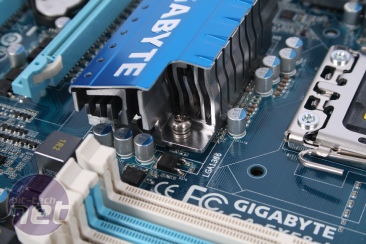Feature List
- Support for Core i7 LGA1366 CPUs at 4.8-6.4GT/s QPI
- Intel X58 Northbridge and ICH10R Southbridge
- Four 1.5V DDR3 DIMM slots supporting up to 16GB of memory
- One Realtek 8111D Gigabit Ethernet controllers
- Two PCI-Express 2.0 x16 slots (x16/x16)
- One PCI-Express x4 slot
- Two PCI-Express x1 slots
- Two PCI slots
- Eight SATA II ports - six from Intel ICH10R (supporting RAID 0, 1, 10, 5 and JBOD), two from Gigabyte (JMicron) SATA2
- One IDE port and one Floppy port
- Ten USB 2.0 ports - six on rear I/O, four via pin-outs
- T.I. TSB43AB23 IEEE1394a FireWire supporting two ports - one via pin-out, one on the rear I/O
- Realtek ALC888S 7.1 Channel High-Definition audio codec
Board Layout
The UD3R features a similarly good layout to its more expensive and better kitted out brethren. The chunky heatsinks have meaty look that gives you a bit of confidence about their cooling ability, and the X58 northbridge is properly screwed down for maximum contact and despite the size they didn't obstruct the installation of our Thermalright Ultra-120 eXtreme 1366RT for example. Equally, the board's DIMM sockets are far away enough for the fan and our Corsair Dominator memory to be fitted without clashing and all the power, SATA II and other connectors are where you would expect to find them around the edges of the board, facing outwards.
Gigabyte cuts down the phase use to 8+1 for CPU and northbridge, using the higher quality environmentally sealed Ferrite cored chokes and smaller Power-PAK MOSFETs, with another standard phase of power for the memory slots. The whole board gets a mixture of cheaper (but still good) Nippon Chemicon and Sanyo solid capacitors, which still do the job just fine, although we have to say the build quality of our UD3R is not up to the usual Gigabyte standards as many of the capacitors didn't fit even nearly flush with the board.
Rather than the more usual six, there are only four DIMM sockets on this board. They're colour-coded so that the second socket from the CPU a different colour to the others - this tells you that this socket is attached to the first memory channel. Using the blue DIMM socket when overclocking could therefore lead to issues, as it means that your memory channels will have different memory amounts (and possibly speeds). Furthermore, installing three sticks in the three sockets closet to the CPU (two white, one blue) results in only two sticks being recognised.
Because it has just four memory sockets, the UD3R will support a maximum of 16GB of memory instead of the usual 24GB providing you buy the latest 4GB sticks. We have to say 6GB for a gaming machine or multitasker is ample but should you feel the need for the space for upgrading, invest a little more on something like a UD4P or go for the MSI X58 Pro instead.
Being an X58 board, the two 16x PCI-E lanes provide 16 lanes of bandwidth to two ATI graphics cards simultaneously for your CrossFire pleasure. However, unlike pricier X58 boards, the UD3R is not officially compatible with Nvidia's SLI, although by flashing the BIOS with the Gigabyte GA-EX58-UD3R-SLI it can be enabled because the hardware is essentially the same. The same goes for the MSI X58 Pro and X58 Pro SLI as well.
The problem is the graphics slots are very close together - we'd have liked to see some extra space for better cooling - the MSI is better in this regard.
Two x1 PCI slots, one x4 PCI-E slot and two regular PCI slots provide additional connectivity for any other expansion cards, however despite being open ended, the x4 sits with the battery right behind it making it useless for longer cards. Not only that, it's right under the primary graphics slot as well making it almost redundant.
Running two dual-slot graphics cards in CrossFire leaves you with the two x1 PCI-E slots and one PCI slot, but even then the upper most x1 slot is limited by the fact the northbridge heatsink is right behind it - making longer cards like the Asus Xonar DX soundcard unable to be used. A very stubby PCI-E WiFi card does, but little else. The second 1x PCI-E slot jams any card placed in it up against the chipset heatsink too, which is far from ideal.
Gigabyte has used eight 90 degree SATA-II connectors, all of which are RAID-capable. Six of the ports come from the Intel ICH10R Southbridge, while the two white SATA-II ports are powered by Gigabyte's own (and annoyingly style guide-breaking) SATA2 chip. A regular IDE header sits in an awkward position toward the bottom of the board which makes using it with optical drives in the top of case a bit of a nightmare, while thankfully there's no wasted space on a Floppy header at all.
The rear I/O block is well equipped for a relatively cheap board, with eight USB 2 ports, a FireWire port and optical and coaxial S/PDIF outputs in addition to the regular six analogue audio ports.

MSI MPG Velox 100R Chassis Review
October 14 2021 | 15:04















Want to comment? Please log in.